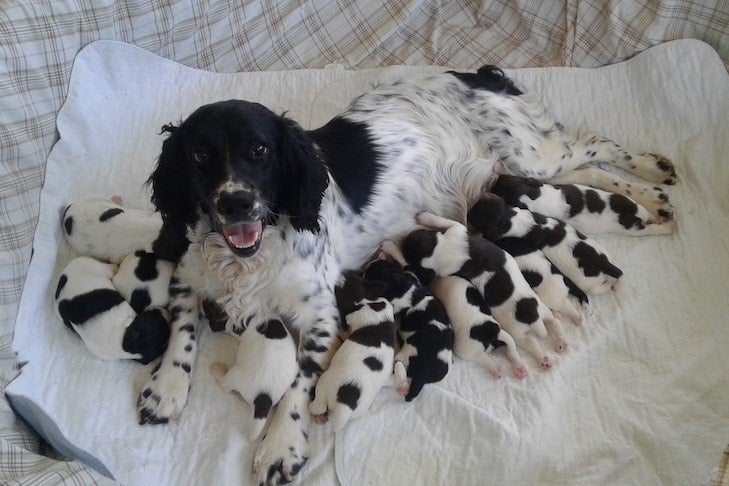Clubs Offering:
Breeding dogs and producing puppies is a rewarding experience. Every litter is unique in some ways, and it takes many years to gain the experience to recognize signs of potential problems and know what steps can be taken to intervene and potentially save the lives of puppies.
Breeders should be present when a dam delivers her puppies, especially if it is her first litter or if she is an older female. You may be able to take quick action, if needed, to help prevent the mortality of puppies. During whelping, one of the most common causes of puppy mortality is hypoxia, or a lack of oxygen. A green or greenish-black discharge from the dam indicates placental separation.
“If this discharge appears and not all the puppies are whelped, they may not be getting enough oxygen,” advises Fran Smith, DVM, Ph.D., DACT, a board-certified veterinary reproduction specialist.
Other signs of potential problems include strong persistent labor for 30 minutes without delivery of a puppy, weak or intermittent labor for six hours without delivery of a puppy, or three or more hours having had passed since the last puppy was born, with more puppies expected to be delivered.
“I recommend having a pregnancy radiograph taken during the last week of pregnancy so that the number of expected puppies is known,” says Dr. Smith.
Giving medications such as oxytocin or ergometrine to induce labor in females having weak contractions could contribute to hypoxia. According to Dr. Smith, you should consult your veterinarian before using these medications, as they facilitate premature placental separation and can be dangerous.
If neonates are small in size when they are born, you can help stimulate their respiration and keep them warm by rubbing their bodies and drying them. Newborn puppies with a low birth weight may have immature lungs, which could cause them to become hypothermic with a dangerously low body temperature.
“The neonatal period from birth to 3 days of age is a critical stage for puppies,” cautions Dr. Smith. “Intervention in the first 72 hours should be used judiciously. Experience can help tell you when to intervene. if you are unsure, you should talk to your veterinarian.”
If you notice these signs in puppies during the first 72 hours after birth, you may need to consult your veterinarian. Intervention could save the life of a newborn puppy at risk.

Pawprint Oxygen offers the following oxygen therapy equipment for puppies and kittens:
This is a lightweight, easy to use, portable option. Canisters coupled with a fixed flow regulator are a useful and practical option to have on hand as an emergency rescue oxygen source and for transport to your primary care or emergency veterinary practice. Each canister provides up to 20 minutes of oxygen therapy. Note: The flow rate and duration are not amenable to use with oxygen cages.
The at home Oxygen Concentrator works by drawing in room air and purifying it into oxygen gas (>90%). While non-portable (it plugs into your home electric outlet) , it can provide oxygen for an indefinite period of time. The Concentrator can generate enough flow to fill and maintain an Oxygen Cage. It can therefore be used with both the Pet Oxygen Mask and the Oxygen Cage. However, it cannot be used for transport. Anytime an oxygen cage is being used, the rescue oxygen system is recommended as a back-up and for transport to a veterinary facility.
Nursing Difficulties for Baby Newborn Puppies
For the first few months of life, puppies will considerably depend on mama dogs milk for necessary nutrients and vitamins for them to grow healthy and strong.
According to Pets WebMD, the normal birth weight for puppies depends greatly on what the breed of the pups is. Throughout the first few weeks of life, a healthy pup’s body weight will increase to up to two to three times. Newborn pups who don’t gain sufficient weight or lose significant weight during these specific weeks have lesser chances of survival.
Transporting & traveling with newborn puppies safely!
Smart puppy care will pay for itself over an over again. Here I will share 7 breeding management tips you can routinely use to prevent the death of newborn and young puppies.
It’s downright heartbreaking when you get your hoped-for litter and get through the woods of the whelping, only to have puppies start dying on you. You feel so helpless! It’s one of the most common problems my breeders reach out to me for. And the good news is that losing suckling puppies is often very simple to prevent.
Obviously, for all sorts of reasons. To sort out an answer, it helps to look at the age at which the babies are passing away.
Smart puppy care begins at birth. Birth is a pretty stressful process for puppies, as with any animal. Things get squashed and squeezed. The biggest cause here of dying puppies is normally associated with lack of oxygen. Until they take their first breath, puppies rely on their mother for oxygen, delivered via the umbilical cord. During passage through the birth canal pressure on the cord can obstruct this life-giving flow, especially if it’s a tight fit.
Breech births where the hind feet present first, rather than the head, further delay the puppy’s access to breathable air.
Puppies deprived of oxygen during the birth process will often be born limp and seemingly lifeless, or, of course, dead.